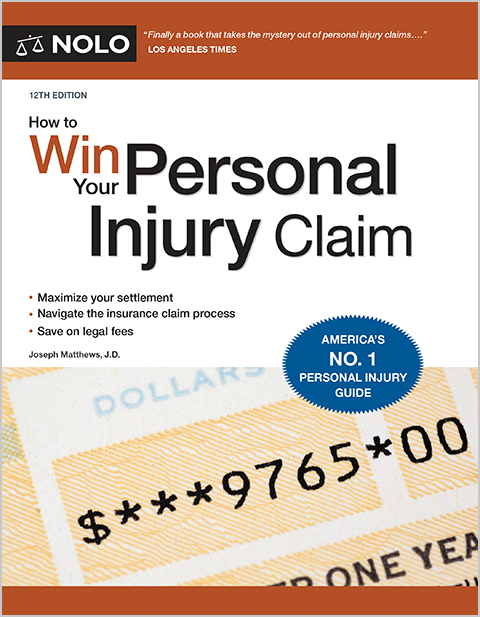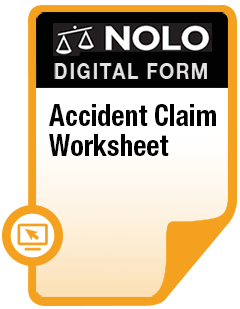Here are the factors that weigh most heavily in valuing your slip and fall claim, with calculations and examples to illustrate.
You were hurt in a fall on someone else's property and you're thinking about making an insurance claim. Before you do, you need to answer these two questions.
- Is someone else legally responsible ("liable") for my fall and resulting injuries?
- If the answer to the first question is yes, then how much is my case worth?
We briefly touch on the first question, but this article assumes the answer is: Yes, you can prove someone else is liable for your fall. If you're new to the law of personal injury accidents, you might want to start by learning more about the basic liability rules.
Our focus is on the second question—the value of your claim. Your goal should be to estimate a range of likely values, not to come up with a single, specific number. To make that calculation, you'll need to consider:
- whether you were partly to blame for your fall
- the nature and severity of your injuries
- the treatment you received, and
- your damages.
Armed with this information, you'll be better positioned to arrive at an informed and well-reasoned estimate.
Liability for Slip and Fall Accidents
A slip and fall claim is a type of premises liability case. To win damages, you must prove that the property owner was legally responsible for your fall. Proving liability can be surprisingly tricky, and your best bet will be to get help from an experienced slip and fall lawyer.
In general, though, fault in a slip and fall case usually comes down to two issues.
- Keeping the property safe. The owner or occupier has an obligation, most often, to keep the property reasonably safe for people who enter with permission.
- The visitor's behavior. As a rule, visitors must use a property for its intended purposes. And the law expects them to be reasonably careful to protect their own safety. We cover this requirement in the next section.
Learn more about proving liability in specific kinds of slip and fall cases, including:
- falls in stores and businesses
- an accident on snow or ice
- a fall at someone else's home
- falls caused by dangerous stairs
- a fall on rental property
- a fall resulting from a dangerous sidewalk, and
- claims against the government for falls on public streets and sidewalks.
We also might have an article about your state's slip and fall laws.
Are You Partly to Blame?
In a slip and fall case, the answer to this question is probably yes. Why? Here's the question the insurance adjuster (or the insurance company's lawyer) will ask: "Did you see whatever caused your fall before you slipped or tripped on it?" There really are only three possible answers to this question:
- No, I didn't see it.
- Yes, I did see it.
- I don't recall whether I saw it or not.
No, I Didn't See It
This answer is an admission that you weren't watching where you were going before you fell. Had you been paying attention, the argument goes, you would have seen the condition and could have taken some action to avoid it. You're partly at fault for not paying attention.
Yes, I Did See It
This answer is an admission that you saw the condition but failed to do anything to avoid it. Be prepared for the obvious follow-up question—"Why didn't you do anything to avoid it?" There aren't many good answers to that question. You're partly at fault for failing to avoid the condition that you saw before you fell.
I Don't Recall Whether I Saw It or Not
This might seem like a clever answer but in reality, you're just inviting more unpleasant questions that won't end well for you. For instance, an adjuster or lawyer might ask you: "Would you agree with me that if you had seen the condition before you fell, you would have taken steps to avoid it? And so, because you did fall, can we agree that you must not have seen it?"
Tell the Truth and Let Your Lawyer Handle the Fallout
The rule is simple: Tell the truth. Always. Your lawyer's job is to deal with the facts and to argue them in a way that puts you in the best possible light.
For example, there might be good reasons why you didn't see whatever caused you to fall. Maybe you were keeping track of your kids. Or your attention was distracted by in-store displays. This is exactly the kind of thing you pay a lawyer to handle, so let them do their job.
What Happens If You're Partly at Fault?
So, there's a good chance you'll be found partly to blame for your fall. The impact on your case depends on the state where you fell.
In a few "contributory negligence" states, any fault on your part—even the tiniest bit—is fatal to your case. It kills your slip and fall claim entirely. Today, only four states (Alabama, North Carolina, Maryland, and Virginia) and the District of Columbia follow this outdated rule. If your fall happened in one of these places, having legal representation will be critical.
In most states, called "comparative negligence" states, your share of the fault reduces the value of your claim by that amount. For instance, let's say that your total damages are $20,000. If the property owner is 100% at fault, the value of your claim is $20,000. But if you're 30% at fault, you must reduce your damages by your share of the fault—$6,000—to arrive at the correct value of your claim, which is $14,000.
Learn more about what happens if both sides are at fault in a personal injury case.
Your Injuries Impact the Value of Your Claim
Several of the factors that have the biggest impact on the value of your claim—your injuries, medical treatment, and damages—are closely related. Your injuries dictate the medical treatment you receive, your medical treatment drives your medical bills, and your damages are calculated, in part, based on your medical bills.
Next to liability, the single most important factor driving the value of your claim is your injuries. If your injuries are serious and their effects will be permanent, your claim is worth more than if your injuries are minor and you quickly recovered. Lawyers and insurance adjusters often divide injuries into two groups:
- hard injuries, and
- soft tissue injuries.
Hard Injuries
We've all suffered these at one time or another—a cut or bruise, or a broken bone or torn ligament. Everyone knows that these injuries are painful, can be disabling, and need medical care and plenty of time to heal. Here are some kinds of hard injuries:
- broken bones
- head injuries
- dislocations
- ligament or cartilage tears
- open wounds, and
- spinal disc or vertebrae injuries.
Soft Tissue Injuries
These are physical injuries that usually can't be seen, including things like sprains and strains. Like hard injuries, soft tissue injuries are painful and can be disabling. They might also require medical care and they take time to heal.
How Are Different Injuries Valued?
As a rule, hard injuries have greater value than soft tissue injuries. Why? For starters, insurance adjusters sometimes view soft tissue injuries as nuisance cases having little worth.
Hard injuries, by contrast, are more likely to require invasive and extensive medical treatment. As a result, the medical bills associated with hard injuries are usually higher than those from soft tissue injuries. Additionally, hard injuries can be seen—they're obvious, or they show up on an X-ray or CAT scan. This makes them easier to understand.
Permanent injuries, including permanent disability or disfigurement, will significantly impact the value of your claim. Suppose, for example, you break your ankle in a fall. Your doctor does surgery to repair the fracture. Later, you develop arthritis in the ankle. The doctor tells you this condition is permanent and will get worse with age. You now must deal with a lifetime of pain and disability.
How Medical Treatment Impacts the Value of Your Claim
The kind of medical treatment you get for your injuries is likely to impact the value of your claim. As discussed above, hard injuries tend to require more extensive, and often more invasive, medical treatments. Fractures, ligament tears, and other internal injuries might need surgery to repair, and casting or splinting for immobilization. Open wounds like cuts or gashes must be closed with stitches. Everyone knows that these treatments cost money, are painful, and require plenty of time to heal.
By contrast, insurance adjusters are likely to be more skeptical of chiropractic care, acupuncture, massage therapy, or other non-physician practitioners. Your focus, of course, must be on getting the care you think best suits your needs. Simply be aware that insurers will not value these nontraditional treatments as highly as they do more "conventional" care.
Damages in a Slip and Fall Claim
Injuries are the physical and emotional harms you suffer because of your fall. "Damages" is a legal term used to describe the value of your injuries and other compensation you might receive for accident-related losses.
In a typical slip and fall case, damages fall into two categories.
- Economic damages. Sometimes called "special" damages, this category includes amounts that come directly out of your (or your health insurer's) pocket. Medical bills, lost wages, and the costs of medical equipment are common examples.
- Noneconomic damages. Also known as "general" damages, these don't come directly out of your pocket, but they're very real. Examples include pain and suffering, emotional distress, disability and disfigurement, and loss of enjoyment of life.
Economic Damages.
Here are some of the most common economic damages in a slip and fall case.
Medical expenses. Medical expenses are likely to be the largest of your economic damages. Examples include:
- hospital and doctor bills
- radiology charges
- billings for lab work
- ambulance costs
- bills from physical and occupational therapists, and
- pharmacy expenses.
Lost Income
If you were away from work for some time because of your injuries, get proof of your lost income. You'll need to document your lost wages and any paid time off you used to cover your time away. Get a letter from your employer's human relations office to prove these amounts.
If you're self-employed, be prepared with proof of both lost income and lost business opportunities—work you lost out on because you couldn't meet with prospective customers or bid on jobs. If you had to pay others to do work you would have done yourself, you can recover those outlays, too.
Other Out-of-Pocket Expenses
You should be reimbursed for any other out-of-pocket expenses you paid because of your injuries. Perhaps you couldn't mow your lawn and had to pay a neighbor kid to do it. Or you couldn't manage routine home repair chores and had to hire a maintenance person. Maybe you had a trip planned and had prepaid, nonrefundable tickets.
All of these incidental expenses are damages for which you should seek payment.
Noneconomic Damages
You're entitled to fair compensation for your pain and suffering, emotional distress, and similar injuries. But first, you've got to put a value on them. How do you measure pain and suffering? Or your emotional distress? There's no one "correct" way.
Most insurance adjusters and lawyers use a formula, multiplying your total medical expenses by a factor (called a "multiplier") of between 1 and 5 to arrive at a value for noneconomic damages. Here's an example. Suppose your medical bills total $9,000. In a typical slip and fall case, you might begin settlement negotiations by using a multiplier of 3, meaning you'd value your pain and suffering, emotional distress, and other noneconomic damages at $27,000.
Your Total Damages
Once you've calculated your economic and noneconomic damages, simply add them together. The sum is your total damages. This amount will be the starting point for calculating the range of values for your claim.
Calculating a Range of Claim Values
Here's one way you can calculate a likely range of values for your slip and fall case. Because you're not likely to be familiar with this process, you should have an experienced lawyer work through it with you.
Making the Calculations
The process begins by figuring your total damages. Here's a quick example.
Compute your total damages. Suppose your medical bills are $8,000 and your lost wages are $1,000, for total economic damages of $9,000. You value your pain and suffering and emotional distress at three times your medical expenses, or $24,000 ($8,000 x 3). Your total damages are $9,000 + $24,000 = $33,000.
Reduce for your share of the fault. Your total damages are just the starting point. Let's assume you put your share of the fault at between 20% ($33,000 x 20% = $6,600) and 33% ($33,000 x 33% = $11,000) of the total, and you're in a comparative fault state. You need to reduce the value of your claim by $6,600 to $11,000, meaning it has a fault-adjusted value of between $22,000 and $26,400.
How much will it cost you to settle? How much will you have to spend to get the insurance company to write you a settlement check? If you're handling the claim on your own, probably not much. Let's say you spend $100 for copies of medical records and bills. Maybe you hire a private investigator to track down witnesses and take photos of the property where you fell. The investigator charges you $1,000.
You'll spend lots of time gathering and organizing materials, writing your settlement demand letter, and negotiating with the adjuster. Your time has value. For purposes of our discussion, let's say it's worth $30 an hour. If you spend a total of 30 hours to get to a settlement, that means your time is worth $900. Your total investment, then, is $100 (copies) + $1,000 (investigator) + $900 (your time) = $2,000.
Arrive at a settlement range. After deducting $2,000 in costs, the range of settlement values for your slip and fall claim works out to $20,000 to $24,400. A lawyer might suggest a few more calculations, but you get the idea.
What does this range tell you? If you get an offer that's within the range, it's likely a fair offer. If the insurance company puts much less than the low end on the table, you'll have to decide (see below) whether it makes sense to file a lawsuit. Anything over the high end of the settlement range is an offer your lawyer probably will tell you to take.
Should You Hire a Lawyer?
If your case doesn't settle and you decide to file a lawsuit, the equation changes. Among other things, your costs will go up quickly. But the value of your case might go up, too. And the insurance company's costs go way up, just like yours do. This means the insurer might be willing to pay more to make the case go away after you file in court.
You should think about hiring an experienced lawyer to handle your case from this point forward. Filing a lawsuit is no simple task. There are complex rules of procedure and evidence that you'll be expected to understand and follow. The insurance company will be represented by experienced counsel who know their way around a case like yours—and who know how to make quick work of unrepresented parties.
If you hire a lawyer, you'll end up paying a contingency fee of 25% to 33% of any settlement or jury verdict you get. And of course, you'll have to reimburse them for any case expenses they advance. Let's take another example.
Suppose that, with a lawsuit filed and a lawyer representing you, the same case discussed above settles for $45,000. The lawyer has spent $6,000 on case expenses. You agreed to pay a 33% attorney's fee, after deducting case expenses. Keep in mind, too, that you spent $2,000 before you filed a lawsuit. The value of your case is $45,000 - $6,000 - $13,000 ($39,000 x 33%) - $2,000 = $24,000.
In this example, hiring a lawyer and filing a lawsuit hasn't increased the value of your case. That said, the equation looks much different if your lawyer is able to settle the case for $100,000 instead of $45,000.
If you're thinking about hiring a lawyer, you'll want to have some frank, candid discussions about the costs and benefits of pursuing a lawsuit. You're likely to come out dollars ahead, but how much will depend on the facts of your case.
Get Help Making Your Decision
Putting a value on a slip and fall claim isn't an exact science. We've covered the factors you need to consider, and we've given you some simple equations you can use to approximate a range of values for your case. But there's more to it than factors and equations.
Don't feel like you need to make this decision alone. Consult with someone who's been there—an experienced personal injury lawyer.


